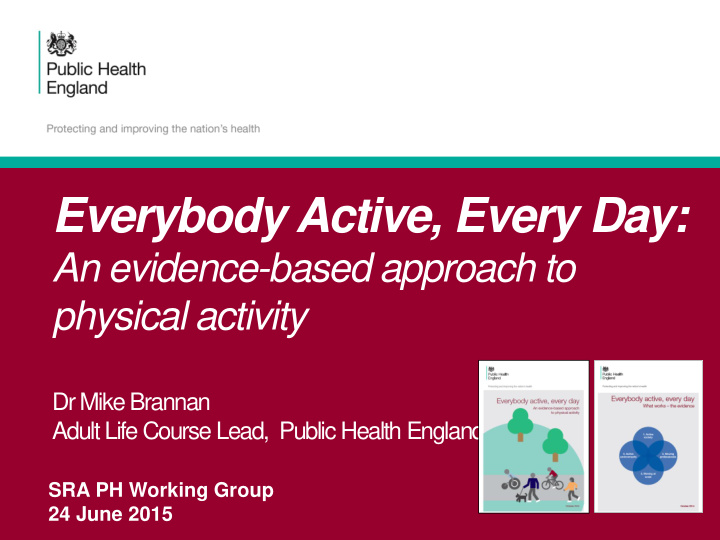



Everybody Active, Every Day: An evidence-based approach to physical activity Dr Mike Brannan Adult Life Course Lead, Public Health England SRA PH Working Group 24 June 2015
Everybody Active Every Day • Consolidates international evidence and co-produced with over 1,000 local and national stakeholders • Supports local leaders to reframe, refocus and provide leadership on: o Cross-sector partnership o Industrial scale action across the whole system o Focus on addressing inactivity as well as increasing physical activity to health enhancing levels • Four domains for national and local action 2
1. Active society – Creating a social movement • Changing general attitudes to make physical activity the expectation or social norm • Working across sectors in the places we live and work • Developing a common vision of: “Everybody Active, Every Day” 3
Activities to date • Visible National Leadership • Cross-government Ministerial & Officials groups • Strong cross-sectoral engagement • National campaigns • Change4Life • One You • Media & communications approach • PHE Blog & twitter • Info-graphics • Targeted trade press 4
Role of sport and recreation • Target and engage inactive people • Engage users in design of locally- embedded physical activity programmes • Deliver services that support inclusive opportunities for physical activity (eg, inclusion fitness initiative-accredited gyms, equity statements) 5 Presentation title - edit in Header and Footer
2. Moving professionals – Activating networks • Utilising existing network of influencers on the public, the public & voluntary sector workforce • ‘Making every contact count’ across sectors and disciplines • Starting with expertise & leadership in key sectors : o Education o Sports & leisure o Health & social care o Planning, design, transport 6
Activities to date • Healthcare Professionals • Undergraduate spiral curriculum for medical & nursing schools led by Nottingham university • Post-graduate free e-learning modules on BMJ Learning platform on physical activity & long term conditions & motivational interviewing skills • Clinical champion programme targeted in 3 regions using Dr to Dr small group teaching • Developing similar curricula and activation approaches for • Sports & Leisure professionals • Teachers • Planners & architects • Toolkit for Members of Parliament 7
Sports & recreation professionals • Support project managers, coaches and volunteers with training and guidance on integration of behaviour change. • Ensure volunteering opportunities and jobs provide skills development and career prospects. • Develop a making every contact count approach that integrates active living into all aspects of business. 8 Presentation title - edit in Header and Footer
3. Active environments – Creating the right spaces • Developing ‘healthy’ cities, villages, towns and communities • Linking across disciplines through planning and policy : o ‘Active’ infrastructure planning o Capital funding investments • Embedding activity for all : o Age-friendly o Disability-friendly 9
Activities to date • A Transport and Health briefing paper for travel planners has been commissioned and will be published in Summer 2015. • Commissioned specific projects looking at rural active travel interventions and interventions to increase functional walking in people with disabilities. • Hosted the Active Travel Consortium partnership group developing recommendations for active travel infrastructure in England 10
Sport & recreation environments • Implement active travel plans for all staff, participants and fans • Identify and address barriers that prohibit equality groups from accessing services (eg, geographic, physical, economic) 11
4. Moving at scale – Interventions that make us active • Positive change must happen at every level and must be measurable, permanent and consistent • Implement ‘what works’ at scale • Maximise existing assets : o Human o Physical 12
Activities to date • Direct support to local partnerships through out Centre teams • Training programme on the standard evaluation framework for physical activity programmes • Data and evidence briefings from knowledge and intelligence teams • Updated NHS cost of inactivity tool • Sub-national embedding events to support local implementation in partnership with NICE 13
Sports & recreation • Establish robust systems to evaluate projects that assess pre and post-project physical activity as well as participation and wider outcomes (using the standard evaluation framework). 14
Evidence for implementation • Synthesis of existing evidence base (e.g. NICE) • Evidence-based actions across public health system : o Settings o Life-course • Includes five key steps for local action : 1. Every child to enjoy & have skills to be active 2. Safe, attractive & inclusive active living environments 3. Make every contact count in public & voluntary sectors 4. Lead by example in public sector workspace Evaluate and share ‘what works’ 5. 15
How can sport and recreation help? 1. Local response to local need 2. Networks of professionals & volunteers who activate & inspire 3. Right professional in the right place at the right time 4. Promotion & partnerships 5. Monitoring & evaluation 16
Embedding health • Musculoskeletal disease prevention • Workplace health • Domestic violence awareness • Mental health & wellbeing • Dementia awareness 17
Let’s get Everybody Active Every Day! Michael.brannan@phe.gov.uk
Recommend
More recommend